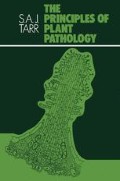Abstract
Parasitic species occur in some families of angiosperms but rather few are important causes of disease in economic plants. Some families such as the Rafflesiaceae are thought to comprise only parasites but most of the families involved contain non-parasitic and parasitic species which are evidently related, the parasitic forms presumably being derived from the non-parasitic ones. Among the more important families containing parasites are the Loranthaceae, Convolvulaceae, Scrophulariaceae, Orobanchaceae, Lauraceae, Santalaceae and Balanophoraceae.
Preview
Unable to display preview. Download preview PDF.
Author information
Authors and Affiliations
Copyright information
© 1972 S. A. J. Tarr
About this chapter
Cite this chapter
Tarr, S.A.J. (1972). Angiosperms, algae and Protozoa as plant pathogens. In: Principles of Plant Pathology. Palgrave, London. https://doi.org/10.1007/978-1-349-00355-6_7
Download citation
DOI: https://doi.org/10.1007/978-1-349-00355-6_7
Publisher Name: Palgrave, London
Print ISBN: 978-1-349-00357-0
Online ISBN: 978-1-349-00355-6
eBook Packages: Biomedical and Life SciencesBiomedical and Life Sciences (R0)

